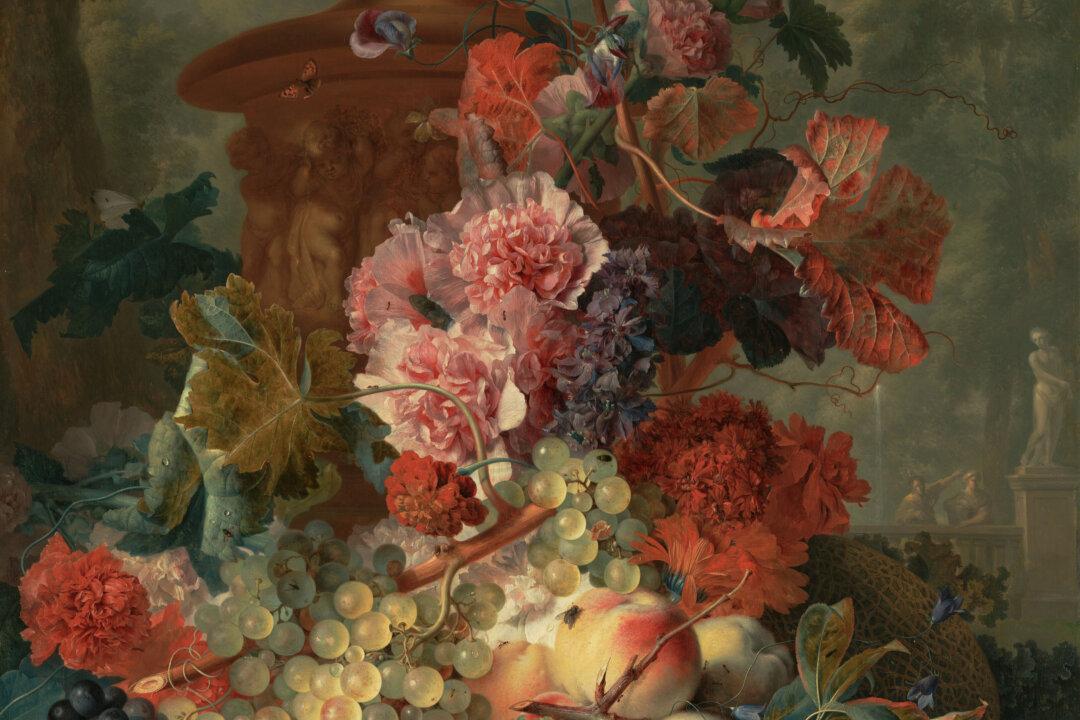The infamously secretive and reclusive artist Jan van Huysum (1682–1749) is considered the 18th century’s greatest Dutch still-life flower painter. His work is revered for its imaginativeness, opulence, rich color, subtle textures, and highly detailed realism.
Key to these achievements was van Huysum’s guarded, painstaking technique of applying layers of thin oil glazes to canvas. His contemporaries never discovered this method, although many tried to imitate him.
Protecting His Legacy

Van Huysum seems to have been destined to become an artist. His father was an art world fixture as a painter and dealer, and his three brothers were also in the profession. Unusual for the day, because of the fragility and seasonal limitation of plants, van Huysum insisted on creating his dazzling bouquet paintings from life.
The Netherlands was and is still a nation obsessed with horticulture. Living in Amsterdam, which at this time was the Dutch Republic’s center of the arts, sciences, and global trade, van Huysum grew specimen flowers in his garden for close study. Furthermore, he was a frequent visitor to local plant nurseries, as well as those in the city of Haarlem.
An artistic trademark was his inclusion of flowers from different seasons in his compositions. Thus, it sometimes took him several years to complete a painting. These bravura works commanded huge sums of money and were eagerly sought after by cultivated patrons, including the kings of Poland and Prussia, Sir Robert Walpole, the landgrave of Hesse-Kassel, the elector of Saxony, and the duc d’Orléans.
Van Huysum’s passion for florals and accuracy was perhaps only matched by his protectiveness over his work and legacy. It’s said that even his brothers were forbidden from entering his studio in case they'd be able to glean how he captured, with such virtuosity, the lusciousness of blooms with mere paint. Unlike other successful artists of this period, van Huysum took only one pupil, but the tutelage ended reputedly because of his paranoia over his student’s skill.
A Trademark Style
The Getty’s “Vase of Flowers” and “Fruit Piece” may have been formulated as companion pieces. In van Huysum’s day, it was common for a flower arrangement and a fruit scene to be painted on separate canvases, with the intent that the works would be displayed as a pair. Both pictures can be traced to the same Dutch collection in the early 19th century, and they stayed together in the same family until being purchased by the Rothschilds in the 1870s. For more than a century, the works remained with them until their acquisition by the Getty in 1982.
“Vase of Flowers” reflects the hallmarks of van Huysum’s style. What command the viewer’s attention are the extravagant and exuberant flowers depicted at different stages: from bud, to full bloom, to post-peak. Expensive, lovingly illustrated species include anemones, auriculas, carnations, delphiniums, honeysuckles, hyacinths, morning glories, narcissi, peonies, roses, and tulips (the flower most associated with Holland). The Getty notes that the composition is “ordered in a loose pyramidal shape, with flowers and greenery almost bursting to be free of the vase. Butterflies and other insects fly or crawl amongst the arrangement, and drops of water are visible.”
The overall effect astonishes the viewer and rewards in-depth observation to identify all of the flowers, insects, and other details, such as the veins of each leaf, individual petals, and the bird’s nest at the edge of the plinth. Even the artist’s signature reflects realism, for it’s painted as if carved into the stone plinth.

Van Huysum employed dramatic lighting effects to create a sense of space within and around the bouquet. He often featured his painted arrangements in burnt-orange terracotta vases that harken to antiquity. “Vase of Flowers” displays a relief scene with classical figures and playful putti. Van Huysum strikes a balance of celebrating the natural world and capturing spontaneity while also revealing his depth of botanical knowledge through the scene’s orchestrated elegance.
In “Fruit Piece,” van Huysum mixes a few florals in an abundant cornucopia of fruits, among berries, grapes, melon, peaches, plums, and a cut pomegranate. Wiry, colorful vines add to the mixture of food and flowers. The Getty writes that in this scene, “[the artist] combined the lustrous realism of [17th-century] Dutch paintings with the bright colors characteristic of the [18th] century. ... The asymmetrical arrangement of bursting and overripe fruit spills over onto the ledge, some falling prey to insects.” A lidded terracotta urn grounds the sinuous, rhythmic composition. It’s carved appropriately with putti carrying grapes.

“Fruit Piece” shows the pivotal development by van Huysum of a light, open-air setting for his still lifes. The backdrop was an important advancement as the genre’s typical setting, as seen in works such as his “Vase of Flowers,” which is neutral and rather dark with directional lighting. “Fruit Piece” is located in an Arcadian, forested landscape with a classical sculpture and two figures visible in the atmospheric haze at right. Yet again, pausing to appreciate minute details in van Huysum’s work rewards the viewer.
Van Huysum’s oeuvre is a high point in the especially rich Dutch tradition of still lifes. Called “the phoenix of flower-painters,” he pioneered new compositions, used a lighter palette, and worked with novel pigments to create his breathtakingly luminous works. Bound with the beautiful and abundant flowers and fruit are meditations about the transience of nature and life: Eventually the flowers will fade and die, and the fruit will spoil. However, van Huysum’s paintings have no shelf life.







